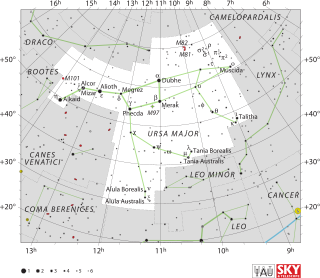
Back Theta Ursae Majoris AST Theta de l'Ossa Major Catalan Theta Ursae Majoris German Theta Ursae Majoris Spanish حوض (ستاره) Persian Theta Ursae Majoris French Theta Ursae Majoris Italian おおぐま座シータ星 Japanese 큰곰자리 세타 Korean Theta Ursae Majoris Dutch
| Observation data Epoch J2000 Equinox J2000 | |
|---|---|
| Constellation | Ursa Major |
| Right ascension | 09h 32m 51.43390s[1] |
| Declination | +51° 40′ 38.2811″[1] |
| Apparent magnitude (V) | 3.166[2] |
| Characteristics | |
| Spectral type | F6 IV[3] |
| U−B color index | +0.03[4] |
| B−V color index | +0.46[3] |
| Variable type | Suspected |
| Astrometry | |
| Radial velocity (Rv) | +14.6[5] km/s |
| Proper motion (μ) | RA: -947.46[1] mas/yr Dec.: -535.60[1] mas/yr |
| Parallax (π) | 74.19 ± 0.14 mas[1] |
| Distance | 43.96 ± 0.08 ly (13.48 ± 0.03 pc) |
| Absolute magnitude (MV) | 2.43[2] |
| Details | |
| Mass | 1.41[2] M☉ |
| Radius | 2.41±0.02[6] R☉ |
| Luminosity | 7.871±0.158[7] L☉ |
| Surface gravity (log g) | 3.80[2] cgs |
| Temperature | 6,256±82[6] K |
| Metallicity [Fe/H] | –0.18[2] dex |
| Rotational velocity (v sin i) | 6.8[2] km/s |
| Age | 2.2[5] Gyr |
| Other designations | |
| Database references | |
| SIMBAD | data |
Theta Ursae Majoris (Theta UMa, θ Ursae Majoris, θ UMa) is a suspected spectroscopic binary star system in the northern circumpolar constellation of Ursa Major. It has an apparent visual magnitude of 3.17,[2] placing it among the brighter members of this constellation. The distance to this star has been measured directly using the parallax method, yielding an estimated value of 43.96 light-years (13.48 parsecs).[1]
In 1976, this was reported as a spectroscopic binary system by Helmut A. Abt and Saul G. Levy, giving it an orbital period of 371 days.[9] However, this was brought into question by Christopher L. Morbey and Roger F. Griffin in 1987, who suggested that the data could be explained by random chance.[10] Further observations in 2009 with observations with the Bok Telescope in Arizona did show changes of 180 m/s in radial velocity, although there was not sufficient evidence to support a Keplerian orbit.[11] There is a 14th-magnitude common proper motion companion to Theta Ursae Majoris at an angular separation of 4.1 arcseconds,[12] so this may potentially be a triple star system.[13]
The primary component of this putative system has a published stellar classification of F6 IV,[3] indicating it is a subgiant star that is evolving away from the main sequence. In 2009, Helmut A. Abt listed it with a stellar classification of F7 V, suggesting that it is still on the main sequence.[14] It is larger than the Sun with 141% of the Sun's mass[2] and 241% of the Sun's radius.[6] Consequently, it is shining brighter and evolving more rapidly than the Sun, with a luminosity nearly eight[3] times the Sun's at an age of 2.2 billion years.[5] This energy is being radiated from the star's outer atmosphere at an effective temperature of 6,256 K.[6] At this heat, the star glows with the yellow-white hue of an F-type star.[15]
The McDonald Observatory team has set limits to the hypothetical presence of one or more planets around the primary with masses between 0.24 and 4.6 Jupiter masses and average separations spanning between 0.05 and 5.2 AU.[16]
- ^ a b c d e f Cite error: The named reference
aaa474_2_653was invoked but never defined (see the help page). - ^ a b c d e f g h Cite error: The named reference
mnras384_1_173was invoked but never defined (see the help page). - ^ a b c d Cite error: The named reference
aaa352_495was invoked but never defined (see the help page). - ^ Cite error: The named reference
clpl4_99was invoked but never defined (see the help page). - ^ a b c Cite error: The named reference
aaa418_989was invoked but never defined (see the help page). - ^ a b c d Cite error: The named reference
Baines2018was invoked but never defined (see the help page). - ^ Cite error: The named reference
apj746_1_101was invoked but never defined (see the help page). - ^ Cite error: The named reference
SIMBADwas invoked but never defined (see the help page). - ^ Cite error: The named reference
ajss30_273was invoked but never defined (see the help page). - ^ Cite error: The named reference
apj1_317_343was invoked but never defined (see the help page). - ^ Cite error: The named reference
apj705_1_543was invoked but never defined (see the help page). - ^ Cite error: The named reference
mnras389_2_869was invoked but never defined (see the help page). - ^ Cite error: The named reference
kalerwas invoked but never defined (see the help page). - ^ Cite error: The named reference
apjs180_1_117was invoked but never defined (see the help page). - ^ Cite error: The named reference
csirowas invoked but never defined (see the help page). - ^ Cite error: The named reference
aj132_1_177was invoked but never defined (see the help page).
